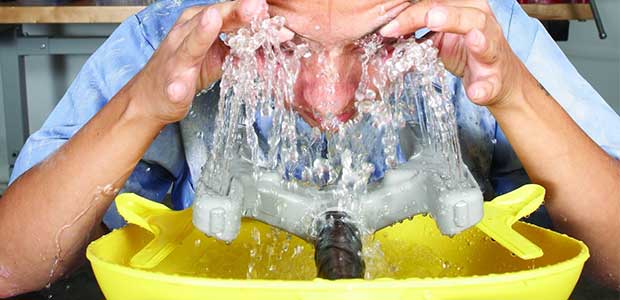
How Lean Design Improves Efficient Use of Emergency Showers and Eyewashes
Management should uncover emergency safety shower procedures and equipment that are not doing the job sufficiently or correctly.
- By Ryan Pfund
- Aug 02, 2021
In an emergency, every second counts. So, when the need arises to use eyewashes and emergency safety showers, eliminating any waste and inefficiency from the process can mean the difference between a good outcome and a bad outcome. Just as “lean” principles have been used to improve manufacturing efficiency, lean can be applied to almost any work application or production process, including improving the performance and efficiency of emergency safety showers.
Now that more facilities are fully reopening and full-time operations are returning to normal, it’s important for safety managers to take a close look at the efficient use of emergency safety showers in their work environments, operations and processes. Are adequate quantities of safety showers and eyewashes confirmed to be in the correct placement relative to site hazards? Is the equipment tested regularly and working properly according to ANSI/ISEA Z358.1–2014 American National Standard for Emergency Eyewash and Shower Equipment? Are employees fully trained on the use of safety shower equipment?
Conversely, management should uncover emergency safety shower procedures and equipment that are not doing the job sufficiently or correctly. A thorough site evaluation can identify disorganization, old bad habits and outdated equipment and systems that create waste, inefficiencies and unsanitary conditions.
Leaning into a Streamlined Emergency Response
Lean design is a process-driven approach that examines the layout, flow, processes and protocols of a worksite, focusing on identifying and eliminating problems.
According to the American Society of Mechanical Engineers (ASME): “The goal of lean is to eliminate waste—the non-value-added components in any process. Unless a process has gone through lean multiple times, it contains some element of waste. When done correctly, lean can create huge improvements in efficiency, cycle time, productivity, material costs and scrap, leading to lower costs and improved competitiveness. And remember, lean isn’t restricted to manufacturing. It can improve how a team works together, inventory management, and even client interaction.”
In the case of using eyewashes and safety showers, lean design can help to streamline each process by minimizing unnecessary movement and waste, which can also offset cross-contamination. Specifically, lean can help a worksite minimize the number of steps taken to a safety fixture, eliminate the frantic search for equipment in an emergency and avoid delays in activating the flushing fluid.
Applying lean design principles, the following emergency shower eyewash and shower technologies help to conserve space, increase efficiency and improve hygiene for use in a variety of work settings which, in turn, boosts safety and performance.
Swing-activated eyewash models. For facilities such as laboratory environments and tight workspaces, a new generation eyewash model combines a sink faucet with an eyewash built in for emergency eyewash use, offering a highly efficient and convenient space-saving solution.
During regular faucet use, the eyewash is stored out of the way. In an emergency, the eyewash is immediately activated when it is swung out 90 degrees over the sink. When the eyewash is activated, the swing-activated design ensures that the faucet moves out of the way, positioning the eyewash directly over the sink and allowing clear access to the fixture. With the eyewash in the optimal position over the sink, water is contained in the sink without dripping or spraying on countertops and floors, which can create mess and the risk of slipping and falling.
Newer models are mounted lower to the deck rather than on the top of the faucet, providing more convenient and comfortable use of the emergency fixture compared with other models on the market, and reinforcing stability and durability of the fixture during use.
Dual use thermostatic mixing valves. Another new “dual use” design for thermostatic mixing valves (TMVs) models delivers safe water temperatures to commercial faucet applications and emergency safety eyewash fixtures. With two valves in one, this design saves installation time and conserves space under sinks.
During regular faucet use, the TMV delivers tempered water for uses such as hand washing; in an emergency, it delivers ANSI/ISEA-required tepid water. Again, this single source design is especially useful for cloistered work applications and laboratory settings.
Eyewash designs for increased hygiene. Especially as we move beyond the pandemic, it’s important to keep eye/face wash systems clean and bacteria-free. One of the newer eye/face wash models comes equipped with a self-draining design that eliminates any settled water in the system. This model also incorporates separate supply and waste pipes to prevent cross-contamination from the clean inlet and wastewater.
Sometimes stagnant water is left over from false activations, tampering and other misuse by workers, leaving equipment vulnerable to contamination. While facility managers can avoid these issues by installing an eyewash alarm system, newer eyewash designs come equipped with either plastic or stainless-steel bowl covers that shield the entire bowl from misuse and contamination.
Some eyewash systems use a sturdy plastic see-through hinged bowl cover. The see-through plastic allows for quick and easy visual inspection and the hinging mechanism provides a more secure hold. The fixture is activated as the cover is opened and may be installed on barrier-free fixtures.
Undoubtedly, every facility has different needs and spatial requirements. Safety managers should assess the layout and processes of a given facility during operations to identify problems and customize solutions. While new technology provides many space and cost efficiencies, ultimately, workers must be trained on why the fixtures are important, where they are located and how to properly use them. Some emergency equipment manufacturers offer free job site evaluations to help identify where efficiencies can be gained, assist with product selection, ANSI/ISEA compliance and training to reinforce protection for all.
This article originally appeared in the July/August 2021 issue of Occupational Health & Safety.